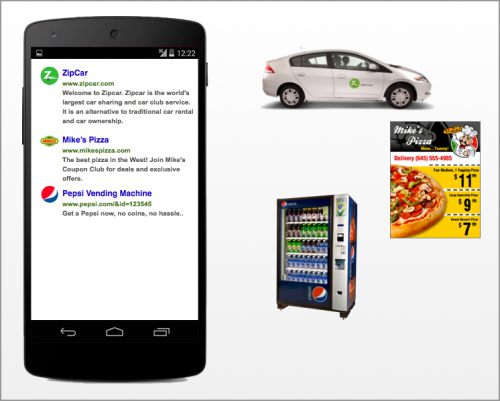October 4, 2014 weblog
The Physical Web project aims to ease smart object interactions

The Physical Web project envisions having URLs, not mobile apps, enable people to use with ease Internet of Things devices. Ease is the key word. A bus stop tells you when the next bus is to appear. A ZipCar broadcasts a signup page and these are only two of the numerous ways the project could grow into something of benefit. The plan is to have people interact with their smart objects, from cars to toys, without downloading any app, in an open ecosystem. "People should be able to walk up to any smart device - a vending machine, a poster, a toy, a bus stop, a rental car - and not have to download an app first. Everything should be just a tap away," said the posting introducing the project. Two things were made clear; the Physical Web is not shipping yet nor is it a Google product. "This is an early-stage experimental project and we're developing it out in the open as we do all things related to the web. This should only be of interest to developers looking to test out this feature and provide us feedback."
Some observers contemplating the future of the Internet of Things refer to dreaded silos of systems and components and the challenges ahead in making sure everything works with everything else. As Engadget associate editor Sean Buckley pointed out, "Most products breaking ground in the "internet of things" exist in their own walled-off ecosystem, often requiring users to download a separate app for every smart device they encounter." The Next Web reporter Josh Ong similarly commented how "The Internet of Things is making objects around us smarter, but we don't have a standard way of interacting with them. Many devices require you to download a custom mobile app, but that's overkill if it's just for a one-time use."
The project team reasoned that, with the number of smart devices to explode, "the assumption that each new device will require its own application just isn't realistic. We need a system that lets anyone interact with any device at any time."
In the Introduction document of the project on GitHub, the project's team assured that the plan does not involve pestering people with disruptive buzzes and alarms. "A core principle of this system is no proactive notifications. The user will only see a list of nearby devices when they ask. If your phone were to be buzzing constantly as you walked through the mall, it would be very frustrating. Push notifications in general are too easily abused. Of course, the user can opt-in to notifications, we are just saying that by default, the user must ask to see anything nearby."
But wait, why are you an app, asked the Introduction page. The answer is that as an early prototype they are trying get people to experiment with this at an early stage. "Of course, this should be built into the operating system of all smartphones (and tablets and anything with a screen really). We are building an app for now that tries to not feel like an app. It works in the background so you don't need to use it actively. It just silently monitors beacons that you can browse when you're interested."
Why URLs? the Introduction page said, "The value of a URL is that it is a known part of the web, very flexible, and most importantly, decentralized. URLs allow anyone to play and no central server to be the bottleneck. This is one of the core principles of the web and critical to keep alive."
At this point, they have both an Android and iOS app that is open source. They hope this will be used and ported to other platforms.
More information:
— google.github.io/physical-web/
— github.com/google/physical-web … tion/introduction.md
© 2014 Tech Xplore




















